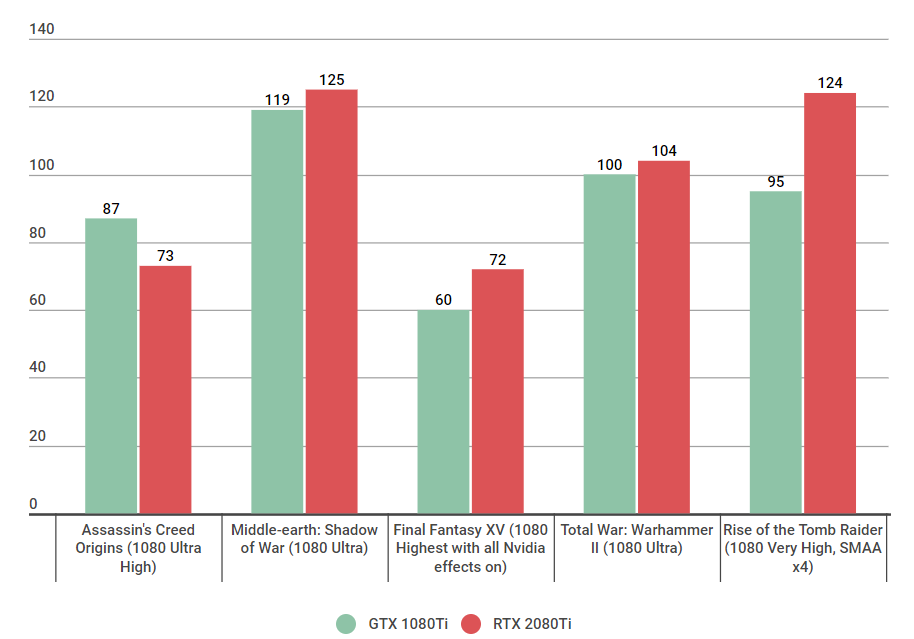
Last week, after a lot hype and pleasure, Nvidia’s GeForce RTX 2080 graphics card was lastly unleashed on the world. Today, it’s the flip of its beefed-up huge brother, the RTX 2080Ti, whose launch was delayed by every week for causes misplaced to the bowels of Nvidia’s advertising and marketing division. As you’ll be able to see from my Nvidia GeForce RTX 2080Ti review, that is fingers down the best graphics card for 4K I’ve ever seen, and that’s all right down to the monstrous energy of Nvidia’s new Turing GPU. But how a lot of a leap does it signify over its instant predecessor, Nvidia’s GeForce GTX 1080Ti? To the graphs!
Much like my RTX 2080 vs GTX 1080 article, the figures you see under are primarily based solely on every card’s uncooked efficiency. We’re nonetheless ready for builders to patch in assist for all of Turing’s best features reminiscent of DLSS (deep studying tremendous sampling) and ray-tracing, so the numbers you’ll discover right here needs to be broadly consultant of what you’ll get for those who have been to stay one in your PC at present. I’ll re-test the suitable games as and when these options begin arriving, however for now, that is what we’ve started working with.
A small notice earlier than we start. I ran my exams with an Intel Core i5-8600Okay and 16GB of RAM in my check PC, and in some instances the previous was clearly holding issues again at decrease resolutions, as outcomes have been both worse or solely a minor enchancment on what the GTX 1080Ti did. As I discussed in each RTX critiques, I’ll be retesting every thing with a greater processor quickly to see if that makes any distinction, so don’t be alarmed if some outcomes look slightly odd.
I also needs to level out that the games I’ve picked listed below are barely completely different to those I included in my RTX 2080 vs GTX 1080 comparability article, as I haven’t been in a position to get one other GTX 1080Ti again in for testing since I did my Final Fantasy XV graphics performance round-up (curse these pesky cryptominers) with Zotac’s GTX 1080Ti Mini.
As such, more moderen games reminiscent of Shadow of the Tomb Raider and Monster Hunter: World are off the menu in the mean time, so I’ve swapped these out for Total War: Warhammer II and Rise of the Tomb Raider as a substitute. Otherwise, we’ve nonetheless bought Assassin’s Creed Origins, Middle-earth: Shadow of War and Final Fantasy XV, they usually’ve all been examined at 3840×2160 (4K), 2560×1440 and 1920×1080 on max settings utilizing their very own inner benchmarks, besides FFXV the place I’ve labored out the common body price from my in-game testing outcomes.
At 4K, the leap in efficiency at most settings is kind of substantial. 10-20fps may not sound like a lot, however when the GTX 1080Ti was typically hoovering across the largely playable but additionally barely janky zone of 30-40fps normally, these dozen further frames or so could make a stunning distinction to how good one thing feels to play. Indeed, the RTX 2080Ti pushed these figures a lot nearer to that elusive 60fps throughout our 5 check games – besides in Tomb Raider, after all, the place that dastardly SMAA x4 anti-aliasing continues to be inflicting chaos even now a few years after its preliminary launch. You can drop that right down to FXAA or SMAA x2 in each instances and get significantly better outcomes with each playing cards, however I selected the highest SMAA x4 setting on this case merely as an instance what playing cards are able to when every thing is maxed out.
That’s to not say the GTX 1080Ti isn’t a very good choice for 4K gaming on a single GPU, after all, as dropping all of those games right down to High will nonetheless internet you a extremely respectable 50-60fps. However, if you’d like a single card setup that gives absolute 4K perfection with zero compromises, the RTX 2080Ti is at the moment the one approach you’re going to get it.
Moving right down to 2560×1440, the GTX 1080Ti already gives greater than sufficient energy for gaming at 60fps at this decision, so that you’ll solely see the variations illustrated above for those who’ve a monitor with a excessive refresh price. On the entire, although, you’re most likely a rise of 15-20fps with the RTX 2080Ti, except you’re taking part in Assassin’s Creed Origins the place it truly carried out worse than its GTX predecessor.
I believe this most likely has one thing to do with my Core i5 appearing as some sort of bottleneck right here, as you’ll see the identical factor occurred once more at 1080p under. Then once more, Final Fantasy XV didn’t present a lot of a rise both, its taxing VXAO Nvidia setting protecting issues regular across the 60fps for each playing cards.
Still, CPU points apart, you’ll get lots out of every card at 1440p, particularly for those who’ve bought a excessive refresh price monitor. Whether you’ll be able to truly inform the distinction between 75fps and 90fps, nevertheless, is one other matter solely. Personally, I don’t suppose my eyes are ok to note an additional 15-odd frames at this sort of velocity, however these with superior sight balls might really feel in a different way.
Meanwhile, at 1920×1080, we’re as soon as once more within the realms of excessive refresh price monitor land right here, albeit with much more extreme CPU bottlenecking than we had at 1440p. Paired with a Core i5, the RTX 2080Ti typically solely confirmed marginal good points at this decision, pushing body charges an additional 5-10fps in Shadow of War, Final Fantasy XV and Total War, and as soon as once more exhibiting no enchancment in any respect in Assassin’s Creed.
Only Rise of the Tomb Raider confirmed the sort of efficiency improve I used to be anticipating from the RTX 2080Ti, providing a lift of round 30fps. However, till I re-test with a greater CPU, it’s onerous to say whether or not you’ll see related leaps elsewhere. Either approach, you’re most likely not shopping for both of those playing cards for taking part in games at 1920×1080 (and if you’re, you’re mad because the Nvidia GeForce GTX 1050Ti or GTX 1060 will do every thing you need at 1080p for a fraction of the price), so their achievements at this decision are, I’d say, comparatively unimportant.
Ultimately, the GTX 1080Ti stays a superb graphics card for these gaming at 2560×1440 and 4K, and so long as you’re proud of High settings at 4K versus Ultra, you then would possibly as nicely save your self a number of a whole bunch of kilos / {dollars} and follow considered one of these as a substitute of shelling out for the £1049 / $1150 RTX 2080Ti. The RTX makes a bit extra sense for those who’ve bought a excessive refresh price monitor, as it is going to clearly be even sooner than the GTX 1080Ti on High at 4K, however proper now I don’t suppose it’s value all the additional cash concerned.
There is, after all, one essential factor lacking from these outcomes, and that’s all of Nvidia’s particular performance-boosting Turing ins and outs. The key one is DLSS, which makes use of AI to assist out with anti-aliasing and smoothing out all these surprisingly taxing sharp edges so the GPU can deal with pumping out extra frames. Admittedly, including in DLSS outcomes most likely gained’t make an enormous quantity of distinction to this specific set of games right here, as proper now the one confirmed DLSS game out of the 5 is Final Fantasy XV. Still, I’ll have an interest to see how a lot of a distinction it truly makes to in-game body charges, and I’ll replace my outcomes accordingly as soon as I’ve been in a position to check it correctly.
Personally, if you wish to purchase a 4K-capable graphics card proper now, I’d nonetheless err on the facet of the GTX 1080Ti. It’s greater than sufficient to deal with most games at High settings at 60fps, and it’s nowhere close to as financially crippling as Nvidia’s shiny new RTX card. Perfectionists might really feel in a different way, however when it comes to worth for cash, the GTX 1080Ti continues to be a troublesome act to beat.





